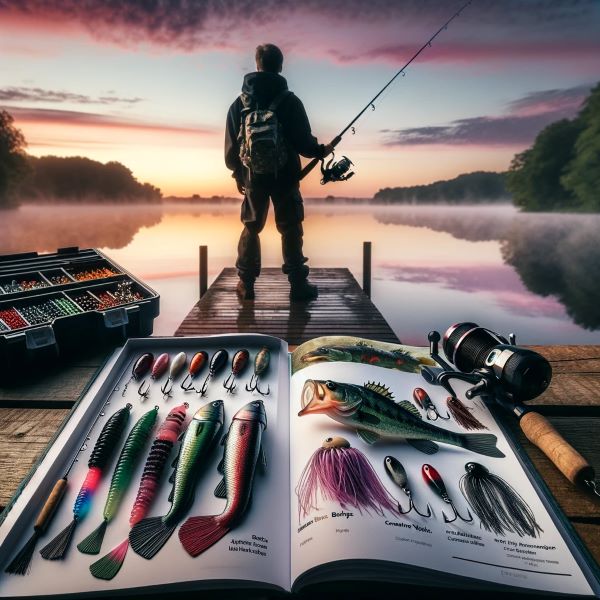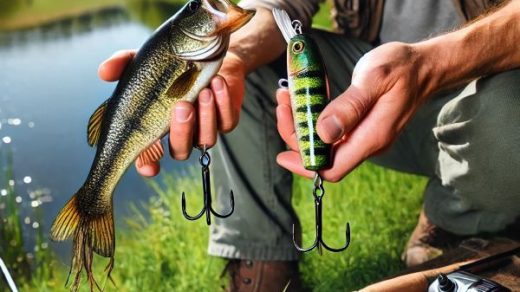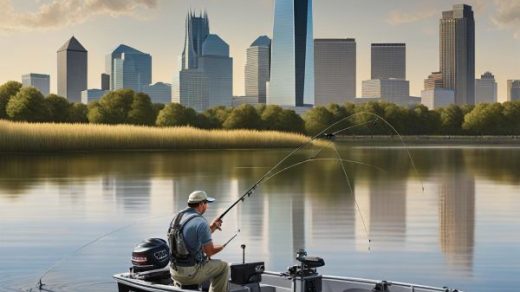
For novices eager to delve into the world of bass fishing, embarking on this angling adventure can be both exhilarating and daunting. With a myriad of techniques, gear choices, and locations to consider, navigating the waters of bass fishing can seem overwhelming at first glance.
However, fear not, as this comprehensive guide is tailored specifically to aid beginners in mastering the art of bass fishing. Whether you’re casting your line for the first time or seeking to refine your skills, these practical tips will equip you with the knowledge and confidence needed to reel in your first bass and embark on a rewarding angling journey.
So, let’s dive in and explore essential bass fishing strategies, tactics, and techniques that will set you on the path to success in this captivating pursuit.
Bass Fishing Basics: Essential Gear and Equipment
When setting out on your bass fishing expedition, ensuring you have the right gear and equipment is paramount. From rods and reels to lures and lines, each component plays a crucial role in your angling success. Let’s delve into the essentials you’ll need to assemble before hitting the water.
- Fishing Rods and Reels:
Selecting the appropriate fishing rod and reel combination is the cornerstone of any angler’s arsenal. For beginners, opting for a versatile spinning rod and reel setup is recommended. These user-friendly options offer ease of use and versatility, making them ideal for novices honing their skills.
When choosing a fishing rod, consider factors such as length, action, and power. A medium-action rod with a length of around 6 to 7 feet provides a good balance of sensitivity and strength, allowing for accurate casting and efficient hooksets. Pairing it with a quality spinning reel that matches the rod’s specifications ensures smooth line retrieval and optimal performance on the water.
- Fishing Line:
The fishing line serves as the vital link between you and the bass, making its selection crucial to your angling endeavors. Monofilament, fluorocarbon, and braided lines are the three primary types available, each offering distinct advantages.
For beginners, monofilament line is often recommended due to its forgiving nature and stretchability, which helps absorb the shock of sudden strikes and reduces the likelihood of line breakage. Opt for a line with a pound test rating appropriate for the size of bass you expect to encounter, typically ranging from 8 to 12 pounds for starters.
- Terminal Tackle:
Terminal tackle encompasses an array of small but essential components, including hooks, weights, and swivels, that are attached to the end of your fishing line. When targeting bass, it’s essential to have a selection of hooks in various sizes and styles to accommodate different bait presentations and fishing conditions.
For beginners, starting with basic worm hooks and bullet weights is a wise choice, as they are versatile and effective for a wide range of bass fishing techniques, such as Texas rigging and Carolina rigging. Additionally, having a few barrel swivels on hand can help prevent line twist when using certain lures or rigs.
Finding the Perfect Bass Fishing Spots
Finding the right fishing spot is essential for a successful bass fishing excursion. Bass are known to inhabit various types of water bodies, from lakes and rivers to ponds and reservoirs. Understanding their behavior and habitat preferences can help you pinpoint prime fishing locations. Here are some key factors to consider when scouting for bass fishing spots:
- Structure and Cover:
Bass are ambush predators that seek shelter and concealment in underwater structures and cover. Look for areas with submerged vegetation, such as lily pads, grass beds, and submerged trees or brush piles. These provide shade, oxygen, and protection, making them attractive feeding and resting spots for bass.
Additionally, pay attention to underwater structures like rock formations, ledges, and drop-offs, which serve as natural ambush points for bass to ambush prey. Using a fish finder or sonar can help identify these underwater features and locate potential hotspots.
- Water Temperature and Clarity:
Water temperature and clarity play significant roles in bass behavior and feeding patterns. Bass are cold-blooded creatures, meaning their activity levels and metabolism are influenced by water temperature.
During warmer months, bass tend to be more active and will seek out cooler, oxygen-rich areas near structure and cover. Conversely, in colder months, they may move to deeper waters or slower-moving currents to conserve energy.
Water clarity also affects bass behavior, with clearer water typically requiring more stealthy approaches and natural-looking lures. Conversely, in stained or murky water, bass rely more on their lateral line and sense of vibration to locate prey, making noisy or brightly colored lures more effective.
- Seasonal Patterns:
Understanding seasonal patterns is crucial for maximizing your bass fishing success. In spring, bass migrate to shallow waters to spawn, making shallow flats, creek channels, and spawning beds prime targets. During summer, they may seek deeper, cooler waters or relate to underwater structures and cover near main lake points and drop-offs.
In fall, bass feeds heavily to prepare for the winter months, often congregating near baitfish schools and transitioning to shallower waters. Finally, in winter, they may become lethargic and move to deeper, slower-moving waters, requiring a slower and more methodical approach.
- Local Knowledge and Research:
Take advantage of local knowledge and resources to uncover hidden gems and insider tips. Talk to fellow anglers, visit bait shops, and consult online forums or fishing reports to gather information on current fishing conditions, recent catches, and productive techniques in your area. Additionally, consider hiring a guide or joining a bass fishing club to accelerate your learning curve and gain access to exclusive fishing spots.
Enticing Bass with Irresistible Offerings
Selecting the right bait or lure is crucial for enticing bass to strike and ultimately landing your prized catch. With a vast array of options available, from live bait to artificial lures, understanding the preferences of bass and matching your presentation to prevailing conditions is key. Here’s a breakdown of some popular bait and lure choices for targeting bass:
- Live Bait:
Live bait remains a staple choice for many anglers seeking to tempt bass into biting. Common live bait options include:
- Nightcrawlers: These large earthworms are readily available and irresistible to hungry bass. Rig them on a hook using a Carolina or Texas rig for optimal presentation.
- Minnows/Shiners: Live minnows or shiners mimic natural prey and can be rigged on a hook or used with a slip bobber to target suspended bass in open water or around structure.
- Crickets/Grasshoppers: These terrestrial insects are excellent choices for enticing bass in shallow, weedy areas, particularly during summer months when they are abundant.
- Soft Plastic Baits:
Soft plastic baits offer versatility and realism, making them highly effective for fooling bass in a variety of conditions. Some popular soft plastic bait options include:
- Senko Worms: These slender, soft plastic worms have a tantalizing action when rigged weightless or wacky style and are deadly on bass in shallow water or around cover.
- Creature Baits: Creature baits, such as crawfish imitations or creature craws, mimic natural forage and are effective when flipped or pitched into heavy cover.
- Swimbaits: Soft plastic swimbaits come in various sizes and designs, ranging from realistic shad imitations to larger profile baits resembling injured baitfish. Retrieve them with a steady retrieve or a stop-and-go action to trigger strikes from bass.
- Hard Baits:
Hard baits, including crankbaits, jerkbaits, and topwater lures, excel at covering water efficiently and triggering reaction strikes from bass. Consider the following hard bait options:
- Crankbaits: Crankbaits come in shallow, medium, and deep-diving variations, allowing you to explore different depths and cover a wide swath of water. Vary your retrieve speed to determine the optimal presentation for enticing bass.
- Jerkbaits: Jerkbaits excel at mimicking injured baitfish and are deadly when worked with erratic twitches and pauses. Experiment with different colors and sizes to match the prevailing forage.
- Topwater Lures: Topwater lures, such as poppers, frogs, and buzzbaits, elicit explosive strikes from bass when worked in the surface film. Use them during low-light conditions or when targeting shallow, weedy areas for maximum effectiveness.
Mastering the Art of Bass Fishing
Successfully landing bass requires more than just casting a line and hoping for a bite. Employing the right techniques and strategies tailored to prevailing conditions and bass behavior is essential for maximizing your chances of success. Here are some proven techniques and strategies to help you master the art of bass fishing:
- Casting and Retrieval Techniques:
Mastering various casting and retrieval techniques is crucial for presenting your bait or lure effectively and enticing bass to strike. Experiment with the following techniques to determine which yields the best results in different situations:
- Pitching and Flipping: Perfect for precise presentations in tight cover, pitching and flipping involve gently lobbing your bait or lure into specific targets with minimal disturbance.
- Skipping: Skipping lures across the water’s surface mimics fleeing baitfish and can trigger aggressive strikes from bass hiding beneath overhanging vegetation or docks.
- Dragging and Deadsticking: Slowly dragging soft plastic baits along the bottom or deadsticking them in place can tempt finicky bass into biting, particularly in colder water or when fish are inactive.
- Depth Control Techniques:
Adjusting your presentation to target bass at the right depth is essential for success, especially when fishing in varying water conditions. Consider employing the following depth control techniques:
- Counting Down: Counting down the seconds it takes for your lure to reach a specific depth can help you consistently target bass holding at a particular depth zone.
- Adjusting Retrieve Speed: Experiment with varying retrieve speeds to keep your lure in the strike zone longer or to trigger reaction strikes from bass.
- Using Weighted Rigs: Adding weights or sinkers to your rig allows you to control the depth at which your bait or lure swims, enabling you to target bass holding at different depths.
- Presentation Techniques:
How you present your bait or lure can make all the difference in enticing bass to strike. Consider the following presentation techniques to increase your chances of success:
- Matching the Hatch: Observing the prevailing forage and selecting baits or lures that closely mimic the size, shape, and color of natural prey can increase your success rate.
- Finesse Fishing: When bass are finicky or under pressure, downsizing your baits and employing finesse techniques, such as drop shotting or shaky head rigging, can elicit strikes from wary bass.
- Imitating Natural Movement: Mimicking the natural movement of prey, such as wounded baitfish or fleeing crawfish, can trigger instinctual strikes from bass. Experiment with different retrieves and lure actions to find what works best.
- Seasonal Adaptations:
Adapting your techniques and strategies to seasonal patterns is essential for staying one step ahead of bass throughout the year. Consider the following seasonal adaptations:
- Spring: Target shallow spawning areas and focus on presenting baits or lures near bedding bass.
- Summer: Fish deeper water or target shaded areas during the hottest parts of the day to find actively feeding bass.
- Fall: Key in on baitfish schools and focus on areas where bass are actively feeding to capitalize on their pre-winter feeding frenzy.
- Winter: Slow down your presentation and target deeper, more sluggish bass with finesse techniques or vertical jigging.
Conclusion:
Bass fishing can be both thrilling and rewarding, and armed with the knowledge and techniques outlined in this guide, beginners can confidently navigate the waters and reel in their share of trophy bass. From mastering the basics of gear selection to honing casting and presentation techniques, each aspect of bass fishing presents an opportunity for growth and discovery.
As you continue to explore and refine your skills, remember that patience and persistence are key virtues in the pursuit of bass. Success may not always come quickly or easily, but each cast brings with it the possibility of an exhilarating strike and the chance to connect with nature in a profound way.
So, whether you find yourself casting lines in tranquil lakes, meandering rivers, or secluded ponds, cherish each moment spent on the water and embrace the challenges and triumphs that come with the pursuit of bass.
With dedication, practice, and a deep appreciation for the beauty of the outdoors, you’ll find that the journey of bass fishing is as rewarding as the catch itself.
Now, gather your gear, chart your course, and set forth on your next bass fishing adventure with confidence and enthusiasm. The waters await, teeming with bass and brimming with the promise of unforgettable experiences. Happy fishing!




